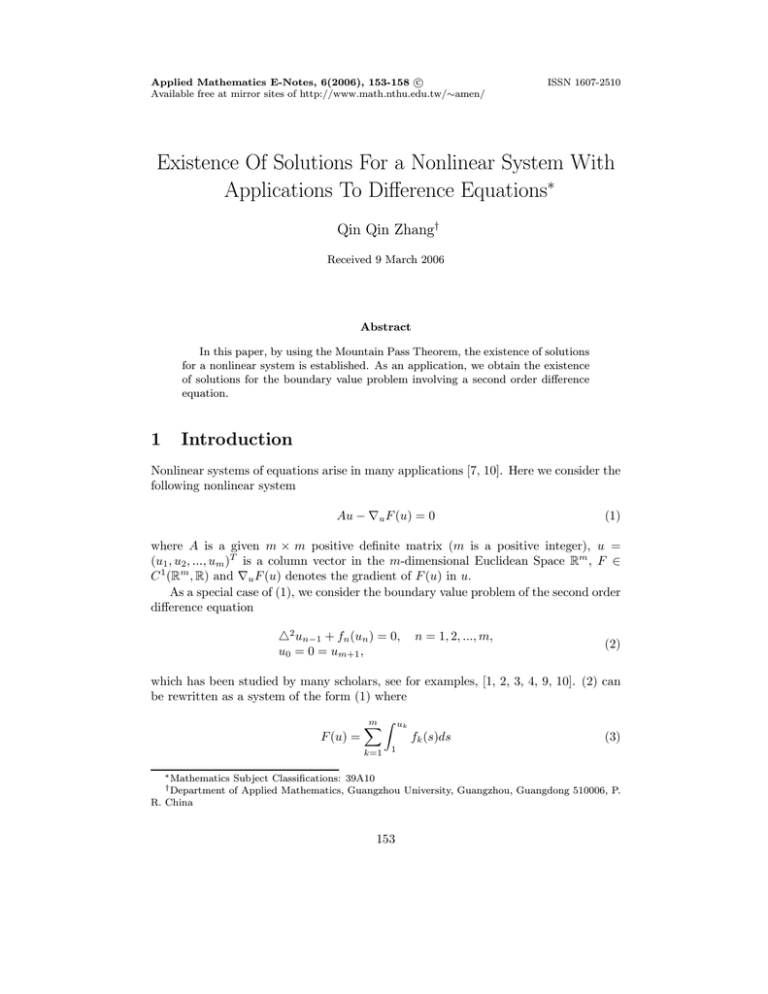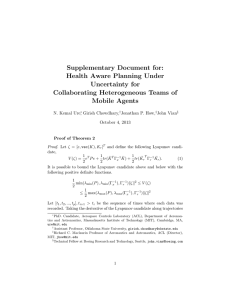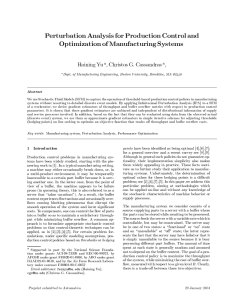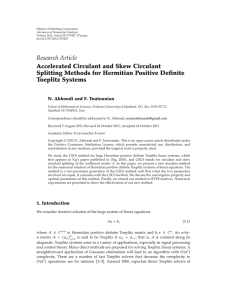Document 10677280
advertisement

Applied Mathematics E-Notes, 6(2006), 153-158 c
Available free at mirror sites of http://www.math.nthu.edu.tw/∼amen/
ISSN 1607-2510
Existence Of Solutions For a Nonlinear System With
Applications To Difference Equations∗
Qin Qin Zhang†
Received 9 March 2006
Abstract
In this paper, by using the Mountain Pass Theorem, the existence of solutions
for a nonlinear system is established. As an application, we obtain the existence
of solutions for the boundary value problem involving a second order difference
equation.
1
Introduction
Nonlinear systems of equations arise in many applications [7, 10]. Here we consider the
following nonlinear system
Au − ∇u F (u) = 0
(1)
where A is a given m × m positive definite matrix (m is a positive integer), u =
(u1 , u2 , ..., um )T is a column vector in the m-dimensional Euclidean Space Rm , F ∈
C 1 (Rm , R) and ∇u F (u) denotes the gradient of F (u) in u.
As a special case of (1), we consider the boundary value problem of the second order
difference equation
2
un−1 + fn (un ) = 0,
u0 = 0 = um+1 ,
n = 1, 2, ..., m,
(2)
which has been studied by many scholars, see for examples, [1, 2, 3, 4, 9, 10]. (2) can
be rewritten as a system of the form (1) where
m
uk
F (u) =
fk (s)ds
k=1
∗ Mathematics
† Department
(3)
1
Subject Classifications: 39A10
of Applied Mathematics, Guangzhou University, Guangzhou, Guangdong 510006, P.
R. China
153
154
Existence of Solutions for Nonlinear Systems
and
⎛
2
−1
..
.
⎜
⎜
⎜
A=⎜
⎜
⎝ 0
0
−1
2
..
.
0
−1
..
.
···
···
..
.
0
0
0
0
···
···
0
0
..
.
⎞
⎟
⎟
⎟
⎟
⎟
−1 ⎠
2
m×m
(4)
is a positive definite matrix.
In recent years, critical point theory has been used successfully to study the periodic solutions and boundary value problems of difference equations[3, 5, 6, 11, 12].
Motivated by these works, in this paper, we make use of the Mountain Pass Theorem
to obtain the existence of solutions of the system (1). For this purpose, we define a
functional I : Rm → R by
1 T
u Au − F (u).
2
(5)
I (u) = Au − ∇u F (u).
(6)
I(u) =
It is easy to see that
Therefore, u ∈ Rm is a solution of (1) if and only if u is a critical point of I(u). To
seek the solutions of the system (1), we only need to find the critical points of I(u).
Let · denote the Euclidean norm in Rm , that is,
1
2
m
u2i
u =
i=1
for u = (u1 , u2 , ..., um )T ∈ Rm .
(7)
THEOREM 1. Assume that F (u) ≥ 0 for u ∈ Rm and satisfies the following
conditions
(F1 ) lim u →0 Fu(u)2 = 0,
(F2 ) lim u →+∞ Fu(u)2 = +∞.
Then system (1) has at least one nontrivial solution.
THEOREM 2. Assume that F (u) ≥ 0 for u ∈ Rm and satisfies the following
conditions
(F3 ) lim u →0 Fu(u)2 = +∞,
(F4 ) lim u →+∞ Fu(u)2 = 0.
Then system (1) has at least one nontrivial solution.
Consider the boundary value problem (2), we can easily get the following corollaries.
z
COROLLARY 1. Assume that fk ∈ C(R, R) and 0 fk (s)ds ≥ 0 for k = 1, 2, ..., m,
z ∈ R. And fRk for k = 1, 2, ..., m satisfy also the following conditions
z
f (s)ds
(H1 ) limz→0 0R zk2
= 0,
(H2 ) limz→∞
z
0
fk (s)ds
z2
= +∞.
Q. Q. Zhang
155
Then the boundary value problem (2) has at least one nontrivial solution.
z
COROLLARY 2. Assume that fk ∈ C(R, R) and 0 fk (s)ds ≥ 0 for k = 1, 2, ..., m,
z ∈ R. And fRk for k = 1, 2, ..., m satisfy also the following conditions
z
f (s)ds
(H3 ) limz→0 0R zk2
= +∞,
z
f (s)ds
(H4 ) limz→∞ 0 zk2
= 0.
Then the boundary value problem (2) has at least one nontrivial solution.
We note that, for the boundary value problem (2), if there exist positive constants
a1 , a2 , M and µ > 2 such that
z
fk (s)ds ≥ a1 |z|µ − a2
0
for |z| ≥ M, k = 1, 2, ..., m.
(8)
Then, fk satisfies (H2 ). And if there exist positive constants a3 , a4 , M1 and 1 < µ1 < 2
such that
z
0≤
0
fk (s)ds ≤ a3 |z|µ1 + a4
for |z| ≥ M1 , k = 1, 2, ..., m.
(9)
Then, fk satisfies (H4 ). Therefore, Corollary 1 and Corollary 2 improve the results of
Theorem 1 and Theorem 2 in [10], respectively.
Now, we provide two examples to show that F (u) may have many other complicated
forms beside the form (3).
EXAMPLE 1. Let
m
F (u) =
i=1
bi |ui |αi + α0 (u41 + u21 u22 + u44 )
where bi > 0, αi > 2 for i = 1, 2, ..., m and α0 ≥ 0. Then F (u) ≥ 0 and satisfies the
conditions (F1 ) and (F2 ).
EXAMPLE 2. Let
m
5
F (u) =
i=1
ci |ui |βi + β0 |u1 | 3 (sin u2 + 1)
where ci > 0, βi ∈ (1, 2) for i = 1, 2, ..., m and β0 ≥ 0. Then F (u) ≥ 0 and satisfies the
conditions (F3 ) and (F4 ).
2
Proofs of Main Results
In this section, we will prove Theorems 1 and 2. To this end, we first state the Mountain
pass theorem which can be found in [8]. Suppose E is a real Banach space. Let
C 1 (E, R) denote the set of functionals that are Fréchet differentiable and whose Fréchet
derivatives are continuous on E. For I ∈ C 1 (E, R), we say I satisfies the Palais-Smale
condition (henceforth denoted by P. S. condition) if any sequence (um ) ⊂ E for which
I(um ) is bounded and I (um ) → 0 as m → ∞ possesses a convergent subsequence.
156
Existence of Solutions for Nonlinear Systems
LEMMA 1 (Mountain Pass Theorem). Let E be a real Banach space and assume
that I ∈ C 1 (E, R) satisfies the P.S. condition. Suppose I(0) = 0 and
(I1 ) there are constants ρ, α > 0 such that I∂Bρ ≥ α, and
(I2 ) there is an e ∈ E\Bρ such that I(e) ≤ 0.
Then I possesses a critical value c ≥ α. Moreover, c can be characterized as
max I(u),
c = inf
g∈Γ u∈g([0,1])
where
Γ = {g ∈ C([0, 1], E)| g(0) = 0, g(1) = e}.
Since the matrix A is positive definite, the eigenvalues λ1 , λ2 , ..., λm of A are positive. Let
λmin = min{λ1 , λ2 , · · · , λm },
λmax = max{λ1 , λ2 , · · · , λm }.
Then
λmin u
2
≤ uT Au ≤ λmax u 2 .
PROOF OF THEOREM 1. We will use Mountain Pass Theorem to prove the
results. In fact, let E = Rm . Clearly, the functional I(u) defined in (5) satisfies that
I ∈ C 1 (E, R) and I(0) = 0. We now show that I satisfies P. S. condition. Let {I(u(k) )}
be a bounded sequence. Then there exists a positive constant C such that
|I(u(k) )| ≤ C
for k = 1, 2, · · · , m.
According to (F2 ), there exist constants α > 12 λmax and R > 0 such that
F (u) ≥ α u
2
for
u ≥ R.
So,
−C ≤ I(u) =
1
1 T
u Au − F (u) ≤ ( λmax − α) u 2 ,
2
2
u ≥ R.
Thus, {u(k) } is bounded and has a convergent subsequence. I satisfies P. S. condition.
Next, we show that I satisfies (I1 ) in Lemma 1. By (F1 ), there exist positive
constants 1 < 12 λmin and ρ1 such that
F (u) ≤
1
u
2
for
u ≤ ρ1 .
Thus,
I(u) =
1
1 T
u Au − F (u) ≥ ( λmin −
2
2
for u = ρ1 . So, (I1 ) holds.
1)
u
2
1
= ( λmin −
2
2
1 )ρ1
>0
Q. Q. Zhang
157
Last, we show that (I2 ) holds. According to (F2 ) again, there exist constants
α1 > 12 λmax and R1 > ρ1 such that
F (u) ≥ α1 u
2
for
u ≥ R1 .
Thus,
I(u) =
1 T
1
u Au − F (u) ≤ ( λmax − α1 ) u
2
2
2
1
= ( λmax − α1 )R12 < 0
2
for u = R1 and (I2 ) follows.
According to the Mountain Pass Theorem, I(u) possesses a critical value c > 0
which implies that I(u) has a nonzero critical points. The proof of Theorem 1 is
complete.
PROOF OF THEOREM 2. We will show that the functional −I(u) satisfies all
conditions of the Mountain Pass Theorem. In fact, let E = Rm , then −I ∈ C 1 (E, R)
and −I(0) = 0. We will show that −I satisfies P. S. condition first. Let {−I(u(k) )} be
a bounded sequence. Then there exists a positive constant C ∗ such that
|I(u(k) )| ≤ C ∗
for k = 1, 2, · · · , m.
According to (F4 ), there exist constants 0 <
F (u) ≤
2
u
2
for
2
< 12 λmin and R2 > 0 such that
u ≥ R2 .
So,
1
1
−C ∗ ≤ −I(u) = − uT Au + F (u) ≤ (− λmin +
2
2
2)
u 2,
u ≥ R2 .
Thus, {u(k) } is bounded and has a convergent subsequence. And −I satisfies P. S.
condition.
Next, we show that −I satisfies (I1 ) in Lemma 1. By (F3 ), there exist positive
constants M2 > 12 λmax and ρ2 such that
2
F (u) ≥ M2 u
for
u ≤ ρ2 .
Thus,
1
1
I(u) = − uT Au + F (u) ≥ (− λmax + M2 ) u
2
2
2
1
= (− λmax + M2 )ρ22 > 0
2
for u = ρ2 . So, (I1 ) holds.
Last, we show that (I2 ) holds. According to (F4 ) again, there exist constants
0 < 3 < 12 λmin and R3 > ρ2 such that
F (u) ≤
3
u
2
for
u ≥ R3 .
Thus,
1
1
−I(u) = − uT Au + F (u) ≤ (− λmin +
2
2
3)
u
2
1
= (− λmin +
2
2
3 )R3
<0
158
Existence of Solutions for Nonlinear Systems
for u = R3 and (I2 ) follows.
According to the Mountain Pass Theorem, −I(u) possesses a critical value c > 0
which implies that I(u) has a nonzero critical points. The proof of Theorem 2 is
complete.
ACKNOWLEDGMENT. This project is supported by the National Natural Science
Foundation.
References
[1] R. P. Agarwal and D. O’Regan, A fixed-point approach for nonlinear discrete
boundary value problems, Computers Math. Applic., 36 (1998), 115—121.
[2] R. P. Agarwal and D. O’Regan, Singular discrete boundary value problems, Appl.
Math. Lett., 12(1999), 127—131.
[3] R. P. Agarwal, K. Perera and D. O’Regan, Multiple positive solutions of singular and nonsingular discrete problems via variational methods, Nonlinear Anal.,
58(2004), 69—73.
[4] F. M. Atici, Existence of positive solutions of nonlinear discrete Sturm-Liouville
problems, Math. Comput. Modelling, 32 (2000), 599—607.
[5] Z. M. Guo and J. S. Yu, Existence of periodic solutions and subharmonic solutions
on second order superlinear difference equations, Sci. China Ser. A, 46(2003), 506—
515.
[6] Z. M. Guo and J. S. Yu, The existence of periodic and subharmonic solutions to
subquadratic second-order difference equations, J. London Math. Soc., 68(2003),
419-430.
[7] W. G. Kelly and A. P. Peterson, Difference Equations, Academic Press, London,
1991.
[8] P. H. Rabinowitz, Minimax Methods in Critical Point Theory with Applications
to Differential Equations, CBMS Issues Math. Ed., 65, 1986.
[9] G. Zhang and S. S. Cheng, Existence of solutions for a nonlinear system with a
parameter, J. Math. Anal. Appl., 314(2006), 311—319.
[10] G. Zhang and Z. L. Yang, Existence of 2n nontrivial solutions for discrete two-point
boundary value problems, Nonlinear Anal., 59(2004), 1181—1187.
[11] Z. Zhou, J. S. Yu and Z. M. Guo, Periodic solutions of higher dimensional discrete
system, Proceedings of the Royal Society of Edinburgh Ser. A, 134(2004), 1013—
1022.
[12] Z. Zhou, J. S. Yu and Z. M. Guo, The existence of periodic and subharmonic
solutions to subquadratic discrete Hamiltonian Systems, ANZIAM J., 47(2005),
89—102.








